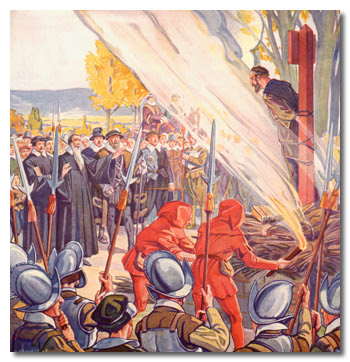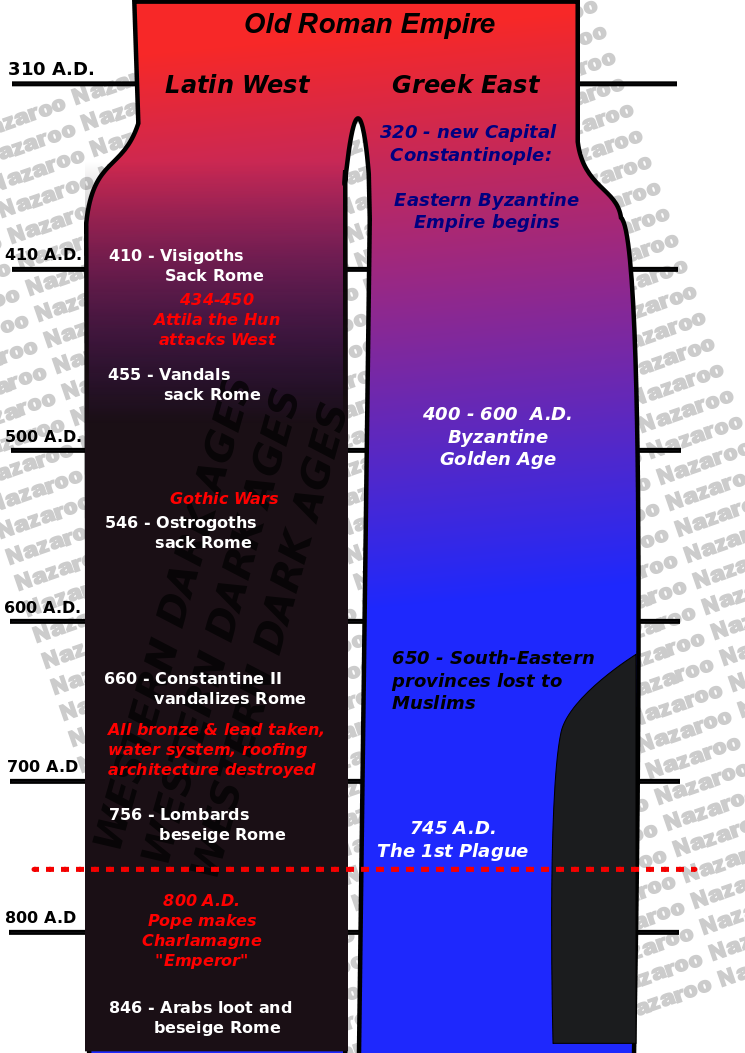While many factors contributed to the phenomenon, one stunning and burning incident did more in the next 4 centuries to promote Unitarianism than any other: The murder of Servetus by Calvin.
Here is an excerpt from Heretics, by Jonathan Wright (NY, 2011) p. 200 fwd:
"Servetus
Shortly after midday on Oct. 27, 1553, Michael Servetus was marched throught the city gates of Geneva [Switzerland], headed for Champel Hill. His heretical meditations on the Trinity had been denounced as "impious blasphemies and insane errors, wholly foreign to the word of God". A guard of mounted archers, robed clergymen and magistates, and much of Geneva's citizenry acompanied the 42 yr. old Spaniard. They would soon witness one of the 16th century's most notorious executions. Servetus was bound to a stake with iron chains, a crown of twigs and sulfur was placed on his head, and sticks of green wood - intended to burn more slowly and thus prolong his suffering - were lit. By some accounts, Servetus let out a cry: "Misericordia, misericordia. Jesus have compassion upon me." A copy of his infamous book - Christianismi Restitutio - burned beneath his feet.
For more than two decades Michael Servetus had been artfully evading those who sought his downfall. At only 20 years of age he had published a book that launched a theologically confused but full-throated assault on the cherished Christian doctrine of the Trinity: the belief in one God as three persons - Father, Son, and Holy Ghost - joined in mystical union, and all three responsible for our salvation. Puzzlingly, Servetus had boldly put his name to this most controversial of tracts (his printer had sensibly remained anonymous), but when inquisitorial proceedings were launched against him, Servetus did not hesitate to adopt a pseudonym. In his new guise as Michel de Villeneuve, he fled to Paris to study mathematics and medicine. A second, and third, career ensued, in which he served time as a proofreader in Lyon and, with some audacity, worked as the personal physician to the princes of the church (including the archbishop of Vienne) he had so offended.
He remained at the theological maverick, however, and in 1545 he made the fateful decision to strike up a correspondence with the great reformer of Geneva, John Calvin. As we've seen, Calvin's theology was itself unfeasibly radical - it exploded centuries of Christian thought about salvation, grace, and predestination - but Calvin was never anything other than a devoted believer in the Trinity. As such, he despised Michael Servetus, and when occasion arose he set about to destroy him. When Servetus's Christianismi Restitutio (a more mature anti-Trinitarian work) was published in 1553, the French authorities arrested him and declared him a heretic. It is likely that it was Calvin who informed his Catholic enemies that they had a covert Unitarian in their midst: a curious, some would say disreputable, moment of cross-confessional cooperation in a century of religious strife. Again however, Servetu made good his escape. Early one morning he scaled the wall of the prison garden in Vienne and headed of to Italy: all that was left to the infuriated French authorities was to burn Servetus in effigy.
Bizarrely, and catastrophically, Servetus decided to stop off at Geneva en route. Since he had arrived on Sunday, he even took the risky step of going to see John Calvin preach in one of the city's churches. Calvin, out of theological distaste and in order to reassert his waning political influence, engineered Servetus' arrest and trial. A boisterous examination of Servetus' opinions followed, in which the heretic was charged with spreading "endless blasphemies", calling the baptism of children "an invention of the devil", and even studying the detested Koran "in order to controvert and disprove the doctrine and religion that the Christian churches hold." Worst of all, he had allegedly described the Trinity as a "three-headed devil, like to Cerberus, whom the ancient poets have called the dog of hell, a monster."
Servetus' guilt was established to the satisfaction of the city's Lesser Council and, while Geneva sought the advice of other Swiss cities about how best to proceed, Servetus languished in prison. He complained endlessly about his plight, "the lice eat me alive", he informed the city magistrates, "my clothes are torn, and I have nothing for a change, neither a jacket nor a shirt"; realizing that his prospects were bleak, he pleaded that he might be killed in as humane a way as possible. It was commonly supposed that the true martyr would endure his final agonies with unworldy serenity. Servetus feared that, if the flames began to lick, he would respond with a distinct lack of courage. As we have seen, his requests fell on deaf ears.
The context of Servetus' execution is all important. By 1553, the rigors of John Calvin's regime were already well known. Nowhere was the concept of a controlled, magisterial Reformation more in evidence. During the 1540s and 1550s, as much as 7 percent of Geneva's population (a startlingly high proportion) was brought before its ecclesiastical tribunal, the Consistory: Protestantism's very own Inquisition.
Some offenders had done nothing more heinous than play cards or don extravagant clothing. Others were adulterers, blasphemers, and religious dissidents, many of whom received punishments - ranging from excommunication, to banishment, to execution - that even by the standards of the 16th century were unusually severe. It was all part of Calvin's plan to reform the morality of the city he hoped to turn into a Protestant paradise.
Pierre Ameaux criticized Calvin's penchant for employing French preachers in Geneva's churches. As punishment, he was made to parade through the city's streets in a hair shirt, begging for forgiveness. Valentin Gentilis held theological views that Calvin found unappetizing, and was made to undergo the humiliation of publicly burning his own books. And yet, even in this oppressive climate, the particularly gruesome death fo Micheal Servetus stands out.
One contemporary, the French theologian Sebastian Castellio (1515-1563), found the whole episode deeply shameful. For Castellio, the execution was an unforgivable act of tyranny. He began to wonder if the very notion of persecuting heretics was not a betrayal of the entire Christian cause. Just what were heretics, Castellio asked: simply "those with whom we disagree". And while you might detest the people with whom you quarreled, it really wasn't appropriate to torture and kill them. Force and violence had no role to play in the arena of religious belief because the truth could not be hammered into people's minds. Persuasion was endlessly more efficient than coercion.
Castellio asked his Christ a rhetorical question. "I beg you in the name of your Father, do you now command that those who do not understand your precepts be drowned in water, cut with lashes to the entrails, dismembered by the sword, or burned at a slow fire?" Did Christ approve of these things being done in his name? "Are they your vicars who make these sacrifices?" Of course not. "O plashemous and shameful audacity of men, who dare to attribute to Christ that which they do by the command and the instigation of Satan."
The subsequent adjudication has been ferocious too. Servetus' execution is an event that has continued to haunt the people of Geneva. In 1909 an expiatory monument was erected on the site fo Servetus' execution. It can still be visited today, where the Avenue de la Rosarie meets the Avenue de Beau-Sejour. Its inscription dutifully pays tribute to John Calvin - "our great reformer" and theman who, after all, made Geneva into one of the most influential cities in Europe - but it also apologizes for the death of Servetus as an odious crime against liberty of conscience. In fact, this was only the most recent outpouring of sympathy for Michael Servetus.
Throughout the 19th century - when notions of religious freedom were very much in vogue - there had been a frenzied competition to see who could erect the most elaborate monument in his memory, or write the most adoring account of his deeds. It became fashionable to refer to Champel Hill, where Servetus was broiled alived, as a second Golgotha.
The truth is that someone like Castellio was very unusual. His condemnation of the Servetus affair won a wide readership and there was a good deal of grumbling about going so far as killing a fellow, if idiosyncratic, Protestant. That, so it was averred, was what Catholics did. Nonetheless, most contemporaries, if they complained at all, only worried about the specific circumstances of Servetus' treatment. Killing him was perhaps a little harsh, and killing him in such a way was a public relations disaster (and, for the record, Calvin himself suggest that Servetus be beheaded - a much less excruciating way to meet your maker). The execution was seen as a scandal across Protestant Europe. Hardly anyone doubted that he had to be silenced and punished, however. The events in Geneva in 1553 have grabbed the headlines for five centuries. Thanks to Castellio's reaction, they are routinely invoked as one of the steps on the road to religious toleration, but in the context of the 16th century Servetus' execution only represented the most extreme articulation of a prevailing logic. Protestantism, in places like Calvin's Geneva, had won the day. It was in charge, and, in the interests of social order and theological respectability, it felt obligated to hammer out its orthodoxies and strike down its heretical enemies."
The importance of Wright's notes here in our view center around his insight into how the torture/murder of Servetus actually drove people away from Calvin and the Trinitarian camp, now perceived as 'yet more Roman Catholic tyranny' and swung public opinion toward religious tolerance of heretical opinion, which was now perceived of as a far lesser social evil than wrongful torture and murder.
In essence, those living in the 19th century perceived religious authorities generally to be tyrannical, despotic, and probably ignorant concerning religious truth. It became recognized that freedom of expression was essential to actual scientific progress and the increase of knowledge.
Nazaroo


















 If you don’t have a finishing press, attach binder clips to the head and tail of the textblock edge. Either stand the block up, balanced on the open binder clips, or lay the textblock on the work surface with the spine extended out over the edge of the table, weighted so that it won’t move while you glue.
If you don’t have a finishing press, attach binder clips to the head and tail of the textblock edge. Either stand the block up, balanced on the open binder clips, or lay the textblock on the work surface with the spine extended out over the edge of the table, weighted so that it won’t move while you glue.







